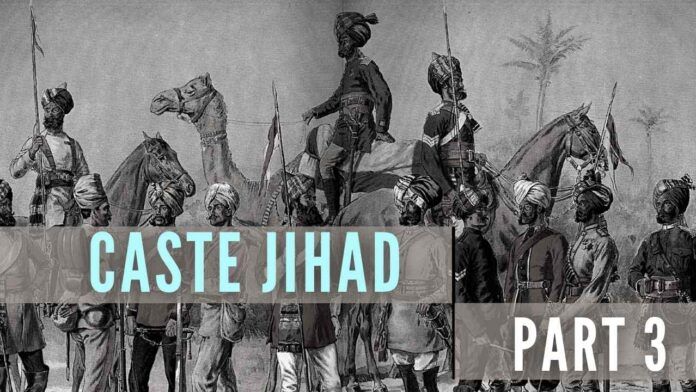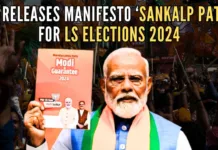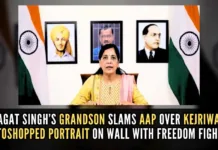
The previous 2 parts of the article can be accessed here Part 1, Part 2. This is the third part
Dalits in Gandhi and Ambedkar’s India (1920s to 1950)
In the earlier part 2, we focused on the census used as a tool for caste-jihad in the Colonial era. The census and the casteism continued but two of India’s foremost statemen – Gandhi and Ambedkar (G&A) – surfaced as social reformers in the political scene. Gandhi was far more deeply involved in the politics and struggle for India’s independence movement than Ambedkar but both dealt with the plight of Dalits, the lowest caste also known as untouchables, and Harijans, in the hierarchical caste system.
Let me start with a sense of pride that neither of G&A resorted to jihadism in their divergent thinking and trying to find ways to uplift the Dalits. Both were well-meaning even in their ideological differences, achieved some success, but at least raised a greater awareness about the social status of Dalits. This part will focus on how and why they differed and perhaps their irreconcilable differences led to no satisfactory resolution on casteism which later became highly politicized in independent India. That continues to date (subject of Part 4) in India but it is also beginning to surface on the U.S. soil (subject of latter parts of this series).
While G&A needs little introduction, the former being from the upper caste only felt and observed the sufferings of Dalits but never experienced it firsthand. Ambedkar, on the other hand, was born into a Dalit family and experienced religious and social barriers like not being allowed to enter Hindu temples, drinking water from the same well as other Hindus, and barriers in the educational opportunities. He continued to experience similar harassment even after returning from his studies in the U.S. and later from the U.K. as a scholar and trained as a lawyer like Gandhi. Thus, their approach to tackling the despicable treatment of Dalits by others in Indian society may have been influenced by their own upbringing in very different family cultures.
Gandhi’s approach was characteristically rooted in eliminating inequality between the Dalits and others by persuading everyone that we are born equal as God’s children (Harijan as he called; Dalits). Gandhi desired that the orthodox Hindus should give up the notion of untouchability and maintain the religious (Hinduism) identity for all irrespective of their “caste.” Ambedkar was also calling for equality but he believed it can happen only if Hindus agree to abolish the caste system. He firmly believed that untouchability had its roots in the caste system which was entrenched in India due to the caste-jihad by the Britishers (1 and 2). The ancient Varna system was already transformed into a hierarchical and evil caste system which I wish was abolished when Ambedkar asked for it in the 1920s.
Ambedkar made rather strong statements like, “We are avowedly out to smash the steel-frame of the caste system.” In retrospect and my opinion, he inappropriately attacked Hindu scriptures, “We refuse to be controlled and bound by the ‘Shastras’ and ‘Smrities’ composed in the dark ages and base our claims on justice and humanity.” The intentional bonfire of Manusmriti by Ambedkar must have widened the gap because of the disrespect he displayed toward Hindu orthodoxy which Gandhi tried to navigate with greater care and caution. For some reason, Ambedkar continued his strong sentiments against Hinduism while Gandhi tried incessantly to keep Dalits as a part of Hinduism.
Later, Ambedkar made a ‘political demand’ to seek a separate electorate for the untouchables in 1931 (similar to already accorded to Muslims and Sikhs in 1916). Subsequently, a fixed number of legislative seats for the untouchables were granted by then Prime Minister MacDonald. Gandhi opposed such a move and went on a “fast” stating that it will be “harmful for [untouchables] and for Hinduism,” Ambedkar called Gandhi’s fast a “political stunt” which was, according to Gandhi, an attempt to keep Hindus unified. In the midst of growing ideological confrontation between G&A, there was a change of heart among Hindus to embrace the untouchables and give them access to public wells and temples. It was resolved, in the so-called Poona act that, “amongst Hindus, no one shall be regarded as an untouchable by reason of his birth and those who have been so regarded hitherto will have the same rights as the other Hindus in regard to the use of public wells, public roads, and other public institutions.”
While there was a “political solution” in the form of the resolution, it did not necessarily change people’s minds and hearts in the whole country. Nevertheless, it was the beginning of improved mutual respect and understanding between the community leaders until another incidence in 1935 when the untouchables were denied access to education in the Ahmedabad district. This reignited the struggle and Ambedkar called upon the Dalit community to disassociate from Hinduism to gain self-respect, power, equality, and independence and create a world in which they could live happily. He also vowed before the crowd of 10,000 strong gathering of untouchables, “that I will not die a Hindu.”
Based on my reading and analysis, it seems that Ambedkar had made up his mind not to remain a Hindu at the displeasure of Gandhi’s intense efforts not to have him and Dalits go out of Hinduism. Ambedkar continued to explore options and reportedly, the Christian, Muslim, and Sikh religious leaders urged him to move to their respective faith. Ambedkar took about 20 years to decide but finally, he and many of his followers changed to Buddhism in the 1950s.
It is fair to say that both G&A may have developed a mutual respect and good understanding even though they agreed to disagree often. Both had a strong calling to make Dalit’s lives better integrated and respected in society but had mixed success, at best. Reportedly, Gandhi asked Nehru to induct Ambedkar as the first Law Minister in his cabinet of free India and as we know, Ambedkar was the architect, brain, and soul of India’s constitution. Ambedkar was also the chief architect of the Hindu Code Bill, the great social reform of the time. This bill, however, never gained Nehru’s approval leading to Ambedkar’s resignation from the cabinet.
Both G&A were very well-respected social reformers, activists, and politicians in their own right. India needed both but India would have been better served if they agreed more often than disagreed on the abolition of the hierarchical and evil caste system. To their credit, they never gave up the social reforms for the untouchables but society as a whole has yet to accept them as equals. Having said that, I can also vouch that the younger generation in rural India makes much less distinction based on caste and there is definitely a change for the better. I have observed the change in dozens of villages when I visit rural schools and interact with children and parents as a co-founder of an NGO Vidya Gyan[1]. The change is happening despite an extreme degree of politicization (the topic of the next article). Do I dare conclude by saying that G&A were too individualists, obstinate characters, and masters of their individual thinking to the detriment of the Dalit cause and evil casteism which, regrettably, continues.
Much of the discussion above is derived from several publications about untouchability at:[2]
To be continued…
Note:
1. Text in Blue points to additional data on the topic.
2. The views expressed here are those of the author and do not necessarily represent or reflect the views of PGurus.
References:
[1] NGO Vidya Gyan – Vidya Gyan
[2] Articles on Untouchability – MK Gandhi
PGurus is now on Telegram. Click here to join our channel and stay updated with all the latest news and views
For all the latest updates, download PGurus App.
- Education and election in Bharat: Race to the top - April 16, 2024
- Kejriwal: “An Insignificant Man” or a corrupt politician with impending prison term - March 24, 2024
- Bharat’s general elections and the Model Code of Conduct - March 22, 2024










